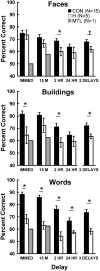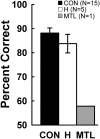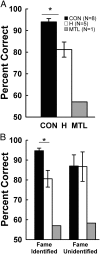When recognition memory is independent of hippocampal function
- PMID: 24958865
- PMCID: PMC4103374
- DOI: 10.1073/pnas.1409878111
When recognition memory is independent of hippocampal function
Erratum in
- Proc Natl Acad Sci U S A. 2014 Sep 9;111(36):13241
Abstract
Hippocampal damage has been thought to result in broad memory impairment. Recent studies in humans, however, have raised the possibility that recognition memory for faces might be spared. In five experiments we investigated face recognition in patients with hippocampal lesions (H) or large medial temporal lobe (MTL) lesions, including patients where neurohistological information was available. Recognition of novel faces was unequivocally intact in H patients but only at a short retention interval. Recognition memory for words, buildings, inverted faces, and famous faces was impaired. For MTL patients, recognition memory was impaired for all materials and across all retention intervals. These results indicate that structures other than the hippocampus, perhaps the perirhinal cortex, can support face recognition memory in H patients under some conditions. The fact that the faces were novel when recognition memory was intact does not fully account for our findings. We propose that the role of the hippocampus in recognition memory is related to how recognition decisions are accomplished. In typical recognition tasks, participants proceed by forming an association between a study item and the study list, and the recognition decision is later made based on whether participants believe the item was on the study list. We suggest that face recognition is an exception to this principle and that, at short retention intervals, participants can make their recognition decisions without making explicit reference to the study list. Important features of faces that might make face recognition exceptional are that they are processed holistically and are difficult to verbally label.
Keywords: amnesia; long-term memory.
Conflict of interest statement
The authors declare no conflict of interest.
Figures





References
-
- Milner B. Disorders of learning and memory after temporal lobe lesions in man. Clin Neurosurg. 1972;19:421–446. - PubMed
-
- Eichenbaum H, Otto T, Cohen NJ. The hippocampus—What does it do? Behav Neural Biol. 1992;57(1):2–36. - PubMed
-
- Squire LR. Memory and the hippocampus: A synthesis from findings with rats, monkeys, and humans. Psychol Rev. 1992;99(2):195–231. - PubMed
-
- Squire LR, Shimamura AP. Characterizing amnesic patients for neurobehavioral study. Behav Neurosci. 1986;100(6):866–877. - PubMed
-
- Reed JM, Squire LR. Impaired recognition memory in patients with lesions limited to the hippocampal formation. Behav Neurosci. 1997;111(4):667–675. - PubMed
Publication types
MeSH terms
Grants and funding
LinkOut - more resources
Full Text Sources
Other Literature Sources
Medical

